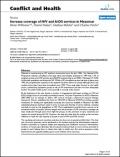Publications - Released in 2008
Myanmar is experiencing an HIV epidemic documented since the late 1980s. The National AIDS Programme national surveillance ante-natal clinics had already estimated in 1993 that 1.4% of pregnant women were HIV positive, and UNAIDS estimates that at end 2005 1.3% (range 0.7–2.0%) of the adult population was living with HIV. While a HIV surveillance system has been in place since 1992, the programmatic response to the epidemic has been slower to emerge although short- and medium-terms plans have been formulated since 1990. These early plans focused on the health sector, omitted key population groups at risk of HIV transmission and have not been adequately funded. The public health system more generally is severely under-funded.
By the beginning of the new decade, a number of organisations had begun working on HIV and AIDS, though not yet in a formally coordinated manner. The Joint Programme on AIDS in Myanmar 2003–2005 was an attempt to deliver HIV services through a planned and agreed strategic framework. Donors established the Fund for HIV/AIDS in Myanmar (FHAM), providing a pooled mechanism for funding and significantly increasing the resources available in Myanmar.






